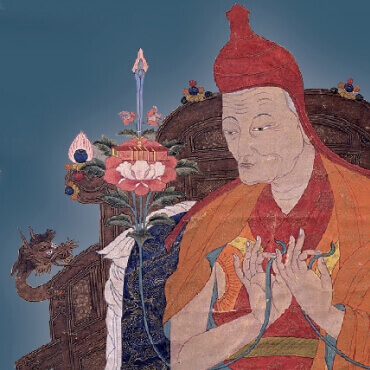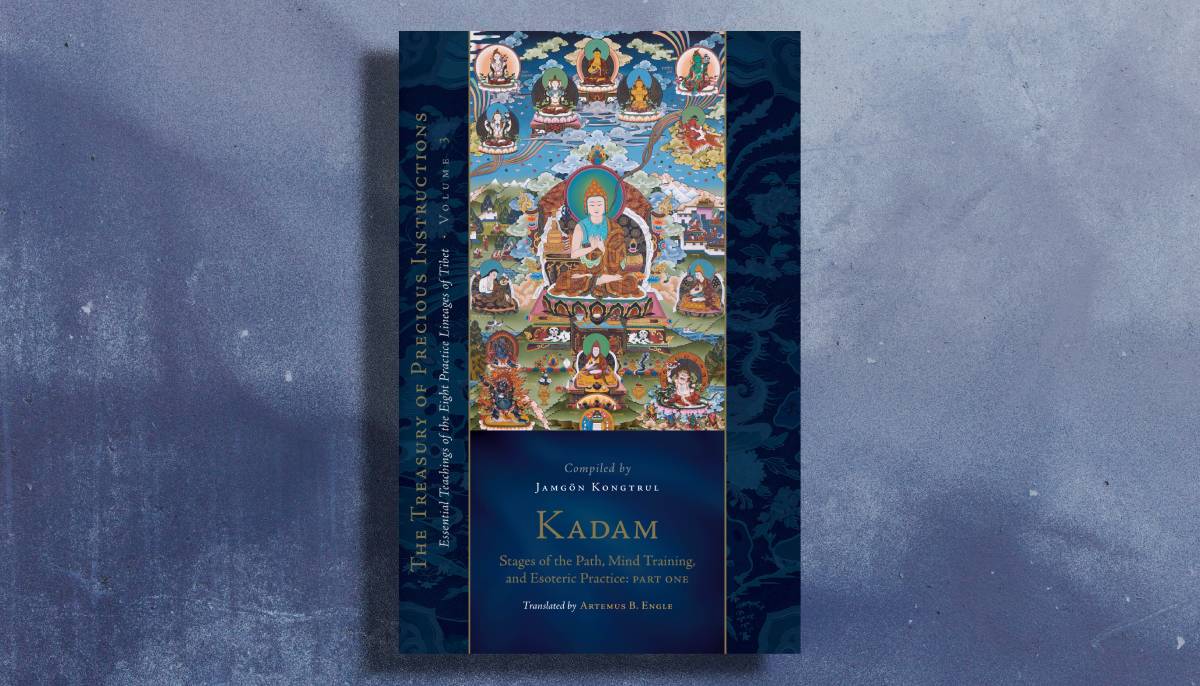Constance Kassor’s review from the Spring 2024 Buddhadharma:
Tibetan Buddhism involves more than esoteric tantric practices. In the nineteenth century, the Tibetan master Jamgön Kongtrul Lodrö Tayé compiled and composed five massive collections of texts in an effort to preserve the teachings of all of the main practice traditions of Tibetan Buddhism. One of these collections, called the Treasury of Precious Instructions, is an eighteen-volume compendium of empowerments, teachings, and practices from various Tibetan Buddhist lineages. The third volume, translated into English by Artemus B. Engle as Kadam: Stages of the Path, Mind Training, and Esoteric Practice: Part One, is the first of two volumes in this compendium that focuses on the Kadam school, which traces its origins back to the Indian master Atisha. The translation of Kongtrul’s compendium is a massive undertaking: this volume alone is over one thousand pages long and includes eighteen different texts by Atisha and other Kadampa masters. Ten works within are associated with Atisha’s well-known text, Lamp for the Path to Enlightenment, while others are associated with the set of practice instructions known as Mind Training. Despite its length, the translations are exceptionally clear and are edited in ways that will help readers in their understanding. In his English translations, Engle has helpfully included the relevant verses of the root text into the passages where they are being explained, and he identifies key words and phrases from the root text that occur in the commentaries themselves. This, combined with extensive notes, makes what might otherwise be a difficult and dense collection of texts readable and accessible. [Please note that the text from which this excerpt derives makes use of endnotes and diacritical; these are not represented in this excerpt.]
The Excerpt: “A Lamp for the Path to Enlightenment”
A Mahayana Scripture on the Stages of the Path Atisa
The Sanskrit title: Bodhipathapradipam
The Tibetan title: Byang chub lam gyi sgron ma
Homage to the bodhisattva Manjushri, appearing as a divine youth.
Having bowed with great respect to all the victors
of the three times, to their dharma, and to the sangha,
I shall explain A Lamp for the Path to Enlightenment
at the request of my excellent disciple Jangchup Ö. (1)
Through being lesser, middling, or supreme,
three types of person are to be understood.
I shall write individual descriptions
that clarify their defining attributes. (2)
One who by various means
seeks only the happiness
of samsara for him- or herself
is known as a lesser person. (3)
Turned away from the happiness of samsaric existence
with a nature that avoids evil deeds,
one who seeks only peace for him- or herself
is said to be a middling person. (4)
One who, through the suffering
of his or her own continuum, truly desires
to terminate completely all the suffering
of others is a supreme person. (5)
I shall explain to those excellent beings
who seek supreme enlightenment
the correct methods
that the gurus have taught. (6)
Facing a painting of the perfect Buddha, and the like,
a caitya shrine, and a holy dharma scripture,
perform acts of worship with flowers, incense,
and other objects, according to your means. (7)
Also perform the sevenfold worship declared
in the Prayer for Excellent Spiritual Conduct.
With an irreversible mind that is maintained
until you reach the seat of enlightenment (8)
and with devout faith in the Three Jewels,
and after placing your knees upon the ground
and joining your palms together,
first go for refuge three times. (9)
Following that, preceded by the attitude
of loving-kindness toward all sentient beings,
examine the entire world of beings who suffer
in the three lower realms, through birth, and so forth,
and by falling downward when they die, and so forth. (10)
Then, with the desire to liberate the world
from the suffering of suffering,
suffering, and the causes of suffering,
generate the enlightenment mind
that makes an irreversible pledge. (11)
The good qualities of having generated
the aspirational mind in this way
are declared by Maitreya
in the Gandavyuha Sutra. (12)
That practitioner should read sutras or hear them
from a guru and learn the limitless good qualities
of the mind directed toward complete enlightenment.
To maintain that mind, it should be generated repeatedly. (13)
Among the descriptions of this mind’s merit
that are found in the Sutra on Viradatta’s Queries,
I shall write here just three verses
as a summary. (14)
If the merit of enlightenment mind
were to become form,
after completely filling the realm of space,
there would be an excess of even more. (15)
Between a person who would give
to the guardians of the world
buddha fields filled with excellent jewels
equal in number to the sand grains of the Ganges (16)
and a person who, having joined the palms together,
would turn his or her mind to enlightenment,
this latter act of worship is superior
and one that has no limit. (17)
After having generated the aspirational enlightenment mind,
you should cause it to develop through many exertions;
and, in order to recall it even in other rebirths,
you should also observe the precepts as they have been taught. (18)
Without the vow whose nature is active enlightenment mind,
the correct aspiration will not become stronger.
Therefore, one who desires to strengthen the vow to attain
complete enlightenment must diligently adopt this vow. (19)
A person who always maintains another vow—
that is, one of the seven types of pratimokṣa discipline—
has the good fortune to develop the vow
of a bodhisattva; otherwise, he or she does not. (20)
Among the seven types of pratimokṣa vow
that were taught by the Tathagata,
the glory of chaste conduct is the best,
which is understood to be the bhiksu vow. (21)
By means of the ritual that is explained
in the morality chapter of The Stage of a Bodhisattva,
you should accept the vow from an excellent guru
who possesses the proper attributes. (22)
One who is skilled in the ritual for the vow,
who possesses a nature that abides in the vow,
who is able to confer the vow, and is compassionate
is understood to be an excellent guru. (23)
If, after striving at this,
you cannot find such a guru,
I shall describe a different ritual
for receiving the vow. (24)
Regarding this, I shall write here clearly
how Manjushri generated enlightenment mind
at a former time when he was Ambaraja, as declared
in the Manjushribuddhaksetralamkara Sutra. (25)
I generate the mind intent upon complete enlightenment
in the presence of the lords.
I invite the entire world of beings
to liberate them from samsara. (26)
I shall not develop malice,
or a rancorous mind, or envy,
or stinginess from this day forward
until I achieve enlightenment. (27)
I shall practice chaste conduct,
I shall abandon sensory pleasures and evil deeds,
and I shall train myself as the buddhas did
by joyfully observing the vow of morality. (28)
I shall not strive here to attain
enlightenment in a swift manner.
I shall remain until the furthest end of time
for the sake of even a single sentient being. (29)
I shall purify a buddha field
that is immeasurable and inconceivable.
I shall cause my name to be celebrated
throughout the ten directions. (30)
I shall cause my deeds of body and speech
to become pure in every way.
I shall also cause my mental deeds to become pure
and I shall not perform any bad deeds. (31)
By abiding in the vow whose nature is active enlightenment mind—
the cause that brings purity to your own body, speech, and mind—
and training yourself well in the threefold training of morality,
you will become one who greatly reveres the threefold training of morality. (32)
Therefore, by striving for purity of the vow in the restraint
of a being who seeks pure and complete enlightenment,
the accumulations for complete enlightenment
will be brought to fulfillment. (33)
All the buddhas agree that the cause
for completing the accumulations,
whose natures are merit and wisdom,
is to develop supernatural knowledge. (34)
Just as a bird that has not grown feathers
cannot fly into the sky, one who lacks
the power of supernatural knowledge
cannot accomplish the welfare of beings. (35)
The merit gained in a day and a night
by one who possesses supernatural knowledge
is not gained even in a hundred births
by one who lacks supernatural knowledge. (36)
One who desires to complete quickly
the accumulations that bring perfect enlightenment
will achieve supernatural knowledge
through exertion, not by idleness. (37)
One who has not attained quiescence
will not develop supernatural knowledge;
therefore, exert yourself repeatedly
in order to achieve quiescence. (38)
One in whom the essential limbs for quiescence
are absent may practice meditation zealously,
but he or she will not achieve one-pointed concentration
even after thousands of years. (39)
Therefore, one who is well established in the essential limbs
taught in the Chapter on the Requisites for One-Pointed Concentration
should fix the mind on any one
of the many virtuous meditation objects. (40)
Once a meditator has attained quiescence,
he or she will also achieve supernatural knowledge.
However, without the practice of perfection of wisdom,
the obscurations cannot be destroyed. (41)
Therefore, in order to abandon entirely the obscurations
of the mental afflictions and to that which needs to be known,
one should meditate continually on the practice of
perfection of wisdom that is accompanied by means. (42)
Because both wisdom without means
and means without wisdom
were declared to be bondage,
do not abandon either of them. (43)
In order to remove uncertainty about
what wisdom is and what means are,
I shall explain the distinguishing characteristics
of means and wisdom. (44)
Excluding the perfection of wisdom,
all the other virtuous qualities6
of the perfection of generosity, and the rest,
were declared by the victors to be means. (45)
One who meditates upon wisdom
with a nature influenced by cultivation7
of means will attain enlightenment quickly,
not by meditating on selflessness alone. (46)
Wisdom is explained to be the knowledge
of emptiness regarding an essential nature,
which realizes the nonorigination
of the heaps, constituents, and bases. (47)
It is not reasonable for an existent thing to arise;
it is also not for a nonexistent one, like a sky-flower.
Nor can that which is both come into existence
because then both errors would follow. (48)
Entities do not arise from themselves;
they also do not from something different than themselves,
or from something that is both, or without a cause.
Therefore, they lack an inherent essence. (49)
Alternatively, when all entities are examined
with regard to being a unity or a multiplicity,
because no inherent nature can be perceived,
it is determined that they lack a real essence. (50)
The reasons in The Seventy Verses on Emptiness,
as well as The Root Verses on the Middle Way, and the rest,
explain how the emptiness of a real essence
is proven in relation to entities. (51)
Because the treatise would become too lengthy,
I have not expounded on this subject here.
Just the established tenets have been presented
so that they might be contemplated. (52)
Therefore, this very meditation on the selflessness
that is the nonapprehension of an essence
in relation to the totality of entities
is meditation upon wisdom. (53)
Just as with all entities, regarding which
wisdom does not see an essence,
meditate in a nonconceptual manner on that very wisdom
that has been analyzed with discerning awareness. (54)
This existence, which arises from conceptual thought,
has the nature of conceptual thought.
Therefore, the complete abandonment
of conceptualization is supreme nirvana. (55)
Moreover, the Bhagavan declared this in the following manner:
“Conceptual thought is the great ignorance
that causes one to fall into the ocean of samsara.
One who abides in the concentration that is free
of conceptual thought shines like the stainless sky.” (56)
The Avikalpapravesadharani Sutra also declares:
“Once a victor’s offspring has developed
a nonconceptual attitude toward this true dharma
and gone beyond concepts that are difficult to transcend,
he or she will in due course attain freedom from conception.” (57)
Having ascertained the unoriginated
and insubstantial nature of all entities
on the basis of scripture and reasoning,
one should meditate free of conception. (58)
After meditating on reality in this way
and successively achieving Heat, and the rest,
Joy, and the rest, will be attained,
and a buddha’s enlightenment will not be far off. (59)
Through the activities of pacifying and prospering, and the rest,
which are gained through the power of mantra,
as well as the power of achieving the vase of fortune, and so forth,
and the eight great spiritual attainments, and the like, (60)
if you wish to complete with ease
the requisites for enlightenment
and you wish to engage in the Secret Mantra practice
taught in the Kriya, Carya, and other tantras, (61)
you should please a genuine lama in every way,
by honoring, giving jewels, and the like,
by following instructions, and so forth,
in order to receive the teacher’s initiation. (62)
By receiving the complete teacher’s initiation
through having pleased the lama,
you become one whose nature has been purified of all bad deeds
and one who is fit to pursue the spiritual attainments. (63)
One who observes chaste conduct should not receive
the secret and wisdom consecrations,
because this is emphatically forbidden
in the Adibuddha Mahatantra. (64)
If one who is observing the austerity
of chaste conduct were to receive those initiations,
the vow of austerity would be ruined
through having engaged in a forbidden act. (65)
That practitioner of austerity will incur
a transgression that is an extreme defeat
and, by falling into the lower realms,
will also not gain any spiritual attainments. (66)
One who has been consecrated as a teacher
is permitted to hear and teach all the tantras
and to perform fire offerings, acts of worship, and the like.
There is also no offense for one who has knowledge of reality. (67)
The elder Dipamkara Sri, who learned
the teachings expressed in sūtras and other scriptures,
composed this brief explanation of the path to enlightenment
at the request of Jangchup Ö. (68)
This concludes A Lamp for the Path to Enlightenment, composed by the
great teacher Dipamkara Srijnana. It was translated, edited, and established
in its final form by the Indian master Dīpaṃkara Srijnana and the translator
Gelong Gewe Lodrö.
From Kadam: Stages of the Path, Mind Training, and Esoteric Practice, Part One by Jamgön Kongtrul Lodrö Taye, translated by Artemus B. Engle © 2024 by Tsadra Foundation. Reprinted in arrangement with Snow Lion/Shambhala Publications, Inc. Boulder, CO. www.shambhala.com. We thank Shambhala Publications for providing this excerpt, and we thank our readers for supporting dharma publishers.
For more on the latest dharma books, read this issue’s edition of Buddhadharma on Books. Or see more excerpts and other digital exclusives for Buddhadharma readers here.

JAMGÖN KONGTRUL LODRÖ TAYE (1813-1900) was a versatile and prolific scholar and one of the most outstanding writers and teachers of his time in Tibet. He was a pivotal figure in eastern Tibet’s nonsectarian movement and made major contributions to education, politics, and medicine.

ARTEMUS B. ENGLE studied Buddhism with the late Sera Mey Khensur Lobsang Tharchin Rinpoche for more than thirty years. Over much of the past decade, he has continued his studies as a student of Gyumé Khensur Lobsang Jampa Rinpoche. In 1983 he earned a doctorate in Buddhist Studies from the University of Wisconsin and is currently a fellow with the Tsadra Foundation.
